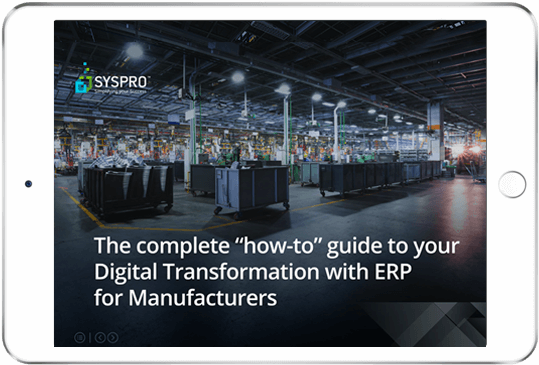Digital transformation is a phrase that has been discussed, exchanged and debated for the last couple of years. In fact, Industry 4.0 — a subset of the Fourth Industrial Revolution — was publicly introduced in Germany, in 2011. It was a government-lead initiative to enhance German competitiveness in the manufacturing industry. Despite the digital call to action, many global manufacturers have been left with trepidation, wondering what it entails and how to go about the journey.
The truth is that knowing where, and how to start, is often the biggest barrier to transformation. Lack of a clear strategy, and a step-by-step plan of action, can result in an organization’s transformation journey stalling before it has gained traction.
ERP is a solution that if well implemented to meet your objectives, will provide benefits that can support a company’s overall digital transformation strategy. Having a roadmap and a checklist of what you need from your ERP will help to guide you through each phase of digitalization and help you to simplify the process as you take those all-important first steps.
Here is a complete practical guide on how you can use your ERP to actively implement various processes that will enable your organization to reap the benefits of Digital Transformation:
1 – Conduct an Audit to Determine Where you Currently Stand on your Digital Transformation Journey
The first step in your digitization journey is to have a clear understanding of your current environment. For example, many manufacturers and distributors are sitting with several analog machines in their factories which still work perfectly well, but being analog, have limited or no facility to connect digitally. Manufacturers should, therefore, consider appointing an automation specialist to conduct an audit of technology, processes, customer interactions and partner interactions to identify gaps and bottlenecks.
2 – Determine What Information You Really Need
Due to the high cost of generating the information, and transferring it to your teams, it is imperative that you know what information you really need to effectively run the plant. The best way to approach the digitalization of your shop floor is to evaluate the effectiveness of your processes.
Within this step, you will need to consider your value to cost ratio. In other words, the cost of gathering the information in a factory against the value of the information received. Selecting an ERP that offers a plug and play solution to digitalize your factory floor, such as an integrated MOM or MES solution to automate data collection, can reduce the associated complexity and costs. You will also need to consider whether your ERP has the right interface to connect to your middleware as ERP software does not automatically connect to machinery.
3 – Assess the Key Features in Your ERP to Go Digital
There are a few key features that should be included in any ERP solution in order for it to help you through your digital transformation, these could include: connected services; machine learning and AI and even digital citizens.
Connected services allow you to expand your supply chain outside of your business, by integrating offerings like Amazon, or Facebook Marketplace, or industry-specific. By being able to integrate the connectors, you reap the benefits of other organizations’ development because you don’t have to put the time, effort and cost into developing them yourself. You can now download a service, such as an Amazon connector, and integrate that into your ERP.
Machine learning and AI tools in your ERP can help to identify trends, get predictions, and identify anomalies. Machine learning can help the business create efficiencies.
There is also a huge opportunity presented by chatbots or ‘digital citizens for customers and staff members. According to an Aspect Consumer Experience Index research report, 71 percent of consumers want the ability to solve most customer service issues on their own, and a growing and preferred means to conduct those self-directed interactions is through chatbots and automated interaction such as SMS and messaging. Your self-service agents are exposed to the world 24/7, they never go to bed, and they are always there answering questions. If you are looking for a digital citizen, or Bot of the future, you should make sure that it has the ability to self-teach and self-learn. In the first few days, your Bot will be quite immature – it won’t know the lingo that your customers might use, or that you use in your organization. As the Bot starts to learn the lingo, the service they provide will improve.
While Industry 4.0 is underway, the best place to start is to understand what you have, and how you currently use it. Decide what you want to achieve from digital transformation and then decide whether the value derived from the data will outweigh the cost to get it. Remember that the aim of 4.0 automation is to free up human resources so they can better focus on strategy and relationship building. Start your journey by reaching out to your ERP provider to see how they can help to guide you through the digital transformation process.
[Download The Free eBook – Your Complete Guide on How to Digitally Transform Your Business Today]








